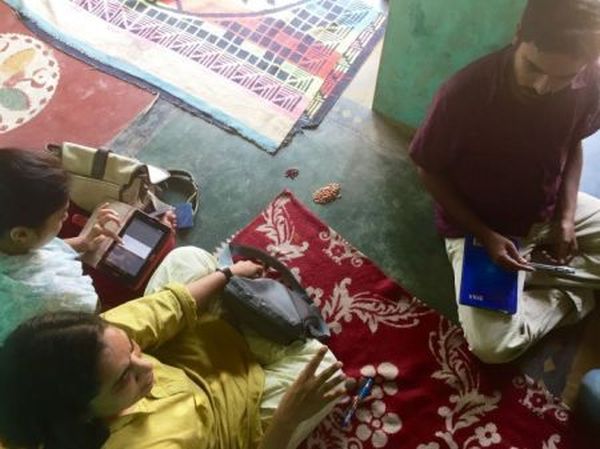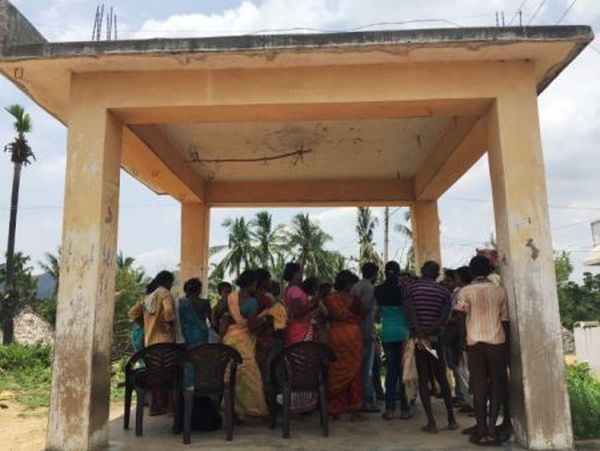From the top to the bottom of MNREGA
 08 January, 2016
08 January, 2016
- Notes from the Field
MNREGA – the world's largest public works programme - is intended to be demand-driven and has local implementation at its core. In this note, Megan Sheahan, Research Support Specialist at Cornell University, shares her experience of visiting MNREGA work sites in some of the most deprived communities in Andhra Pradesh. She finds that while the scheme has enabled a jump in earnings and created useful assets for villagers, beneficiaries have little control over the timing or type of work allocated to them.
In early June 2015, I travelled to India to present research on the varied impacts of the Mahatma Gandhi National Rural Employment Guarantee Act (MNREGA), the legal entitlement behind the largest public works programme in the world, to a room full of impressively engaged Ministry of Rural Development staff and state-level programme implementers. The presentations featured our work under the 3ie-funded project led by Yanyan Liu and in collaboration with Chris Barrett and Sudha Narayanan, but also reviewed some of the other carefully documented analysis related to targeting and implementation, labour market outcomes, agriculture and environment, and welfare impacts of MNREGA. Despite the jet lag, I couldn't help but feel energised by the obvious demand for good research to help improve the MNREGA, especially in a political environment where the future of the programme is debated constantly.
After a long day of discussion in Delhi, I (with Sudha, Upasak Das and Krushna Ranavare) departed for Vishakapatnam district of Andhra Pradesh (AP) where we would spend the next few (very hot) days visiting MNREGA workers and work sites in both the lowland plains near Anakapalle and the tribal areas in the highlands. Our trip was expertly planned by Chakradhar Buddha, an advocate for these especially vulnerable communities, who has written specifically about MNREGA implementation in tribal areas. Sudha perceptively noted how rare and exciting it was to spend one day presenting research to a room full of high-level policymakers and the next day observing how the scheme worked for some of the most deprived communities. I borrowed the title of this post from her observation.
Our charge was simply to better understand how MNREGA, a national programme with local-level implementation at its core, functioned in the vastly different areas we visited. Here is a quick summary of what we learned from the three distinct parts of our journey.
A village in the coastal plains
While relatively accessible to the town of Anakapalle, the plains village of Munagapaka is characterised by a high degree of landlessness and seasonal shortages in work availability. As our group discussion with over 40 women revealed, the casual wage was a mere Rs. 50 per day for women before the introduction of MNREGA. Now these women make Rs. 100-120 per day on the public works sites during the three months when the sites are open.
Despite the large jump in nominal earnings, the consensus was that these wages are only keeping up with the cost of running and feeding a household. The fact that women were paid directly and at levels of compensation just shy of those offered to migrating male construction workers, however, made them "feel like kings" in their households for those three months. Not only were the wages helping to maintain a necessary level of household consumption, but the assets created through the project were already helping village members to navigate seasonal variation in water availability.

Chakradhar Buddha translates questions from Sudha Narayanan and responses from female MNREGA workers. Photo by Megan Sheahan.
Three tribal villages in the highlands
In Vanabangipadu, Cheekumbandu, and Devarapalli, villages populated largely by scheduled tribes and situated a several hours' drive from Anakapalle, we administered a brief survey to about 20 households – stratified by their MNREGA participation level and landholding size – to garner insights about programme performance and impacts. In these areas, at least one member of nearly all households spent some portion of their year working on MNREGA.
Here the top-down nature of MNREGA implementation in AP described in Maiorano (2014) was most obvious; despite the demand-driven intent of the programme, workers had little control over when they could work, for how long, and what types of works would move forward. This year, work sites did not open during the slack summer season as they normally and ideally would, meaning the work will inevitably overlap with the agricultural season and potentially create competition with agricultural labour needs. We also met with the Field Assistant who oversees implementation across six villages and learned that even she was virtually powerless to open projects before even higher levels of implementers agreed.
Discussions with individuals in this area also exposed how little job-card holders knew about their entitlements under the Act, making it difficult to correct the inadequacies of current implementation. Regardless of the imperfections, it was plainly obvious how important MNREGA wages and work were to the beneficiary households.

Krushna Ranaware (with tablet), Sudha Narayanan, and Chakradhar Buddha discuss a strategy for interviewing households in Vanabangipadu. Photo by Megan Sheahan.
The payment system
Back in the coastal plains region of AP, we spent our time trying to better understand the system of payment for MNREGA workers, especially since delayed payment was a recurring complaint in the villages. Wages are paid to workers through the local post office branches where identification of individuals is done using fingerprints and, where necessary, retinal scans. We met the Branch Post Master for Munagupaka and the Assistant Superintendent of Posts in Sachanarayanan, both of whom shared rosy stories of how well the technology worked and cut down on senseless leakage of funds.
The more illuminating experience was accompanying the Village Branch Post Master in Nallaregulapalem to a location where he was scheduled to administer wage payments. At first the payment machine could not establish a connection; then at least one fingerprint failed the recognition test. The gathered wage-seekers spoke freely about their payment grievances. It was clear that the technology worked well - only when it worked.

Wage seekers in Nallaregulapalem explain the shortcomings of the biometric MNREGA payment system. Photo by Megan Sheahan.
Concluding thoughts
We, as development economists, are charged with the responsibility of telling the stories – quantitatively, in our case – of the poorest and often voiceless. My week in India reminded me of the importance of connecting with the individuals behind the data we use as well as with the policymakers who benefit from the narratives we shape. It's difficult to know in a rights-based scheme like MNREGA which ends are the 'top' and 'bottom' but either way I am thankful for the quick but profound opportunity to view nearly the full chain of this massively important programme to India's rural areas.
This article first appeared on 'Economics That Really Matters': http://www.econthatmatters.com/2015/06/from-the-top-to-the-bottom-of-indias-mgnrega-in-one-week/
Further Reading
- Buddha, Chakradhar and Diego Maiorano (2014), "MGNREGA in Andhra Pradesh's Tribal Areas", Economic and Political Weekly 49(51).
- Maiorano, Diego (2014), "The Politics of the Mahatma Gandhi National Rural Employment Guarantee Act in Andhra Pradesh", World Development 58: 95-105.









Comments will be held for moderation. Your contact information will not be made public.